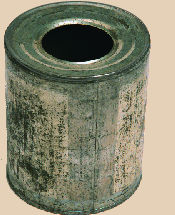
CANS
Everybody wants to find that old six-shooter, bag of bullion, or other historic artifact. But one thing you will see a lot of in your travels to Nevada's historic sites is cans. Lots of cans. Lots of rusty cans. Why are they there? I mean, besides the fact that nobody wants them?
Napoleon spurred the search for preserving food when he offered a prize to the first person to come up with a way to preserve food for his armies. Naturally, a Frenchman claimed the prize in 1809. The next year, Peter Durand patented a tin-plated iron can for use as a food container, and in 1818 introduced the tin-plated can to America. Cans then were pretty thick, and to open them you needed a hammer and chisel.
Canned food was important since farming at the time was more geared towards the raising of meat. There were some vegetables to be had, but it was easier to stock and distribute canned food. Harriet White Fisher complains in Lincoln Highway Adventures: "For about three miles outside of Tonopah one has to travel over a road filled with empty tin cans, bottles, glass, etc. One can see the smokestacks of the mines, pouring out black smoke. Not a garden, or even an attempt at one, did we see in this place; everybody here lives on canned goods."
Most of the cans you'll run across are too rusty to readily identify what was in them, unless they have an unusual shape. However, with a bit of detective work you can  match their construction with techniques available during certain time periods, and make an educated guess as to when they were made and what was inside them. Sometimes by being familiar with the site itself, you can guess what the cans might have contained. For example, these cans at left were found at the Lahontan site. Since we know when the site was active, and the cans have a familiar shape, we can guess that these are tobacco cans. In fact, you can go into a tobacco store and still see tobacco sold in cans like these.
match their construction with techniques available during certain time periods, and make an educated guess as to when they were made and what was inside them. Sometimes by being familiar with the site itself, you can guess what the cans might have contained. For example, these cans at left were found at the Lahontan site. Since we know when the site was active, and the cans have a familiar shape, we can guess that these are tobacco cans. In fact, you can go into a tobacco store and still see tobacco sold in cans like these.
How were they made? Different construction techniques were used at different times. By observing the methods used to make the can, you can date the can and thus- perhaps- the site. In the beginning, cans were made by hand, and it wasn't until Henry Evans invented a device for stamping cans in 1846 that the canning industry really got rolling. His invention increased the number of cans one could make in an hour from six to sixty.
Fairly common in the older camps is the "hole-in-top" can. This can had a large hole in the top (duh) through which the food was put into the can. Then, a flanged lid with a pinhole was soldered onto the hole. During processing, when enough steam had escaped, a drop of solder was put on the hole to seal the can.
You can still find many of these cans laying around. Methods for making cans (and can openers) improved over the years. You can see this evolution by observing the cans you find at historic sites.
Methods for making cans (and can openers) improved over the years. You can see this evolution by observing the cans you find at historic sites.
How were they opened? Can opener development followed can development, but at a discrete distance. While the first cans were opened with whatever tools were available- preferably a hammer and chisel- later cans were opened with tools specifically made for that purpose. Early cans used metal too thick for "normal" can openers to open. The first can opener was patented before the Civil War. It had a long curved blade which was driven into the can and then forced around the edge. The "wheel style" opener we are all used to wasn't thought up until the mid 1920's. Click here to see a small sample of the many can opening devices developed between the middle of the nineteenth century and the early part of the twentieth. Here is a guy opening cans with various antique can openers.
Naturally, a can opened with a hammer and chisel doesn't necessarily mean it was opened.jpg) before the invention of the can opener. The only real inference you can draw was that the opener of the can probably didn't have a can opener.
before the invention of the can opener. The only real inference you can draw was that the opener of the can probably didn't have a can opener.
What size and shape were they? Besides the common cylindrical shape we're all familiar with, there were flat rectangular shapes (sardine cans), flattened pyramid shapes (canned meats), hinged boxes (cigars and pills), rectangular tins (cooking oil), oval (powders), and custom-made odd shapes, like log-cabin-shaped syrup containers. There are lots more shapes.
What was in them? Pretty much the same things you can buy in the grocery store today were available in cans in the old days. Besides tobacco, another common find is condensed milk cans. Coffee was also popular.By ascertaining the exact size, shape, and method of manufacture, you can narrow down the item that may have been in the can. If you, uh, were that interested.